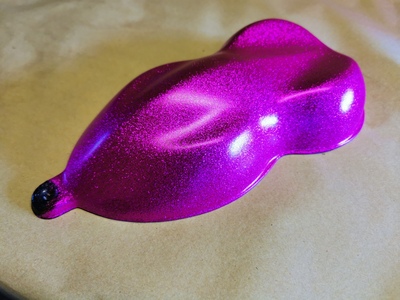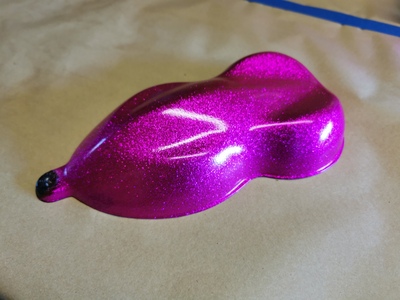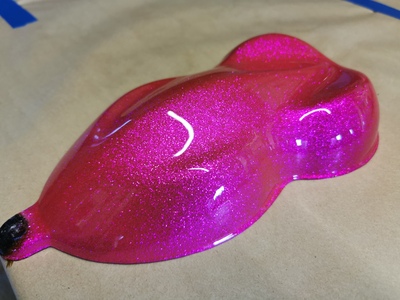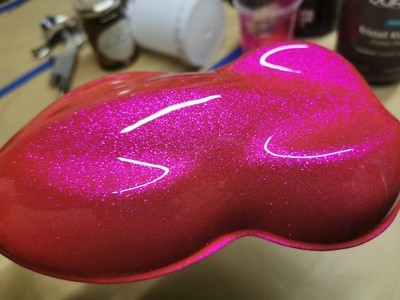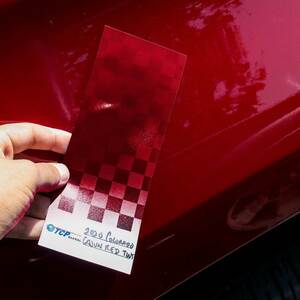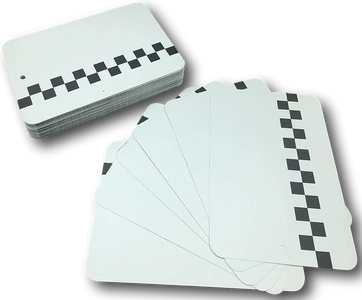@russ These are called “speed shapes”, paint sprayers use them for spray out tests.
This one is done in medium silver metal flake with pink (I know it looks purple) candy over it.
Here it is in the sun before the clear coat.
Make guitars, not war 🌍✌️🎸
I’m testing this colour because I’m painting a full Strat in flake and pink candy for someone. I wanted to make sure it was right before painting the guitar.
Here it is not in the sun but in full clear coat. I’ll see if I can get a better vid tomorrow if the sun is out. It really is bright pink.
Make guitars, not war 🌍✌️🎸
The colour suits you
@deej Thanks man. Look how brown the paint looks on my glove. I took that glove off sharpish because a devilry man turned up and he might have thought I’d been doing something else. 😳💩
Make guitars, not war 🌍✌️🎸
@russ Also used are “spray out cards”. We test spray coloured paint onto them to test certain things about different paints, not all paints are made equal. You can have the same paint, made by the same manufacturer, using the exact same chemical products but different pigments make some less opaque than other colours. So, some colours may gain opacity in two or three coats and some may take many more. Also, if an effective colour needs a coloured ground coat first, that must be tested too. Matching vehicle colours is an art in itself. Every can/vehicle made has a colour code on it from leaving the factory. This can be looked up in a colour code book or microfiche machine (more likely on computer now) and it will tell you exactly how to mix that particular colour, this is done in weight, on scales. It will say take so much of this colour and so much of that and that and that and so on....... you would be surprised how many colour tinters go into a simple colour. And, of one single factory paint job colour, there are countless variants of that colour depending on which factory it was sprayed in and on what date, all of that information is recorded and all of those paint variants are slightly different (sometimes more than slightly). The colour that was always the worst was Ford Diamond White, endless variants and endless colours swatches to hold up to the car’s paintwork. Sometimes I just gave up and painted (blended) the whole side on the car, it’s a way of tricking the human eye.
These are sprayout cards, notice the chequered marks on them so you know when opacity has been gained.
Make guitars, not war 🌍✌️🎸
Can I ask what you think of northwest guitar's rattle cans?
@russ the only rattle can I’ve used from Northwest Guitars is sanding sealer and it did the job. I’m really not a big fan of rattle cans and I hardly ever use them for painting. There is nothing wrong with using them, it just seems pointless when you have the proper gear. I might try doing a full guitar with rattle cans one day, just to remind myself of the differences and to prove that it is a viable option for painting guitars to a decent level.
Make guitars, not war 🌍✌️🎸
I thought I might try to develop some skills with a rattle can before I thought about splashing out on the good gear.
@russ Yeah it’s always good to just have a go and using rattle cans is good if for no other reason than to learn about paint and how it comes out of the can and onto a surface. It’s knowing how much or little to apply and notice how not all rattle can paints are made the same. Temperature and humidity can have a big say how effective the paint is applied and how it dries. Placing a rattle can in a tub of hot water about 10 mins before you paint can really help the paint flow when it’s released, which makes it more consistent. Contaminants are also a good thing to learn about, what causes them and how to fix them because they will inevitably crop up.
I have to say that if I was going to use a rattle can to spray a guitar, I would spend more money on the the upper end of the market, not cheap crap cans. One of the worst thing about rattle cans is that most of them only have a set oval spray pattern when you release the paint. This is really bad for getting the paint on evenly and consistently. Some, however, do have adjustment nozzles so you can get a decent wide fan spray pattern, which is what you want.
Once you make the jump to using proper spray guns though, you never really want to use rattle cans again. You have to really want to do it though and develop a thick skin because it’s not always smooth sailing, it’s an expensive initial financial outlay too. It’s a great feeling when you get a good flow going though and you just keep pumping out the paint jobs, you get stunning results compared to rattle cans. It’s about putting the time, patience and energy into it, you only get out what you put in.
Make guitars, not war 🌍✌️🎸




